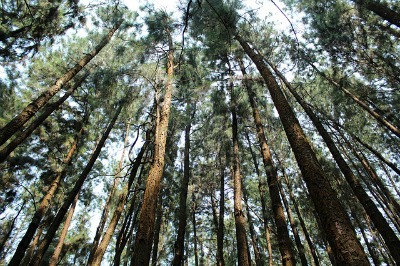The ascent of water in plants has become an interesting subject of inquiry for many years.
Many theories have been proposed but not a single one has yet been recognized unanimously as an exacting explanation.
The transpiration pull is just one of the mechanisms that explain water movement in plants, particularly water ascent in tall trees.
Weight of Water in Plants

Consider the biggest, the most massive trees, and probably the largest living organisms on earth: the Giant Sequoia or Sequoiadendron giganteum.
It has grown since the 1960’s, but data provided by Feininger (1968) showed that the General Sherman Tree at the Sequoia National Park in California, USA used to have a mean basal diameter (d) of 33.3 feet (10.15 m), basal circumference of 107.6 feet (32.8 m), height of 267.4 feet (81.5 m), total trunk volume of 45,232 cu. ft (1,280.83 cubic meters), estimated trunk weight of 565 tons and estimated total weight of more than 1,000 tons.
This tree would stand at about the same height as that of a 26-storey building.
By applying the formula in calculating the area of a circle A = πr2 = (πd2)/4 where π or pi = 3.1416, the base of the tree would occupy a circular ground area of at least 870 square feet or 80 sq. meters.
This ground area would be about the same as that of a rectangular garage or a house flooring having dimensions of 26 feet x 33 feet or 8 m x 10 m.
It was also estimated to contain lumber sufficient to construct 40 houses, each with 5 rooms.
It would take 30 railroad cars to haul the trunk which had to be sliced first into smaller segments.
The data did not include the tree’s percentage moisture content when the tree measurements were taken, but in general, any plant body can contain from 70% to more than 90% water.
Nevertheless, even if the trunk (weighing about 565 tons) contained a mere 10% water, it would still have a massive load of about 5.65 tons or 5,650 kg of water, equivalent to 113 bags of flour or grains weighing 50 kg each.
As cited on another page, a single maple tree 14.5 m tall growing fully exposed to the sun can transpire up to 225 li (approximately 225 kg) of water per hour.
The Impossibility for a Human to Move Water Upward
It would be tiresome for any ordinary human to manually fetch one bag of 50-kg flour or grain through stairs from the first to the second floor of a building without resting.
But how about doing it up to the 26th floor?
Or climbing an electric post or a full-grown coconut tree while carrying the same load?
Surely it would require superhuman powers to move more weights upward.
So what makes water in plants move upward?
How does it manage to reach the tops of giant sequoia or those of the coast redwood (Sequoia sempervirens), also of California, the tallest trees at more than 100 meters tall?
Even in 1966, a coast redwood was already measured to have a height of 369.2 feet or 112.5 meters which approximates the height of a 35-story building (Feininger 1968).
There must be an explanation of how trees manage to push those heavy loads of water upward, at least possible explanations that will tend to lessen the impact of that question.
That is the subject of the forward link provided below.
Environmental Factors Affecting Transpiration <<< >>> Transpiration Pull and Other Theories on Water Ascent
